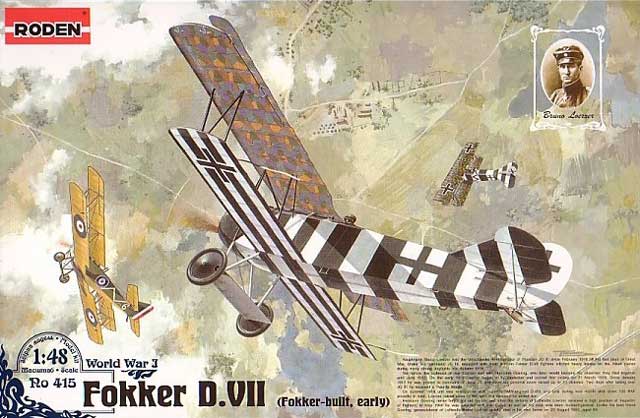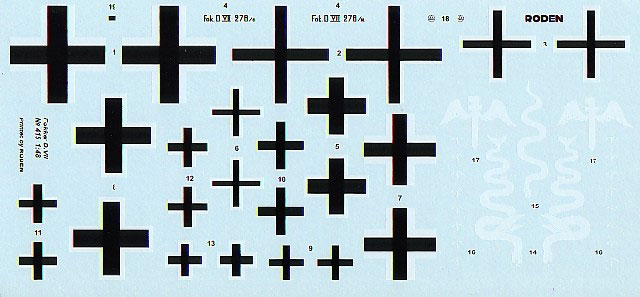|
Fokker D.VII
Fokker built, early

Roden
S
u m m a r y
|
| Catalogue Number: |
Kit #415 - Fokker D.VII (Fokker
early build) |
| Scale: |
1/48 |
| Contents and Media: |
Six sprues of light grey plastic and
three sheets of decal |
| Price: |
USD$17.97 from Squadron.com
|
| Review Type: |
FirstLook |
| Advantages: |
Accurate, well-researched,
superb attention to detail. |
| Disadvantages: |
Lower wing moulding scallop
blemishes. |
| Recommendation: |
Highly Recommended |
Reviewed by Robert Baumgartner

Roden's 1/48
scale Fokker D.VII (early Fokker build) is available online from Squadron.com
With the release of Roden’s 1/72 scale range of this
famous fighter, it was always hoped that something similar might be around
the corner in a larger scale. Well… it has arrived.
This is the first of many D.VII kits, each with their
own differences to represent Fokker, Albatros
and OAW-built machines.
Upon opening the box, it is immediately obvious that
this kit is a step above what we have seen previously from this
manufacturer.
Inside there are six sprues
of light grey plastic and three sheets of
decal.

Click the
thumbnails below to view larger images:
As with it’s smaller predecessor, Roden supply both
the Mercedes and BMW engines that powered the D.VII. These engines are
well detailed and are designed to be exposed within the confines of the
forward fuselage. This really opens up some diorama potential!
To allow for the different nose configurations, the
fuselage halves have been designed in two pieces. This permits the saving
of tooling costs when alternate radiators and engine cowls are produced to
accommodate future versions. Those supplied in this kit are for the early
Fokker manufactured types.
As mentioned previously, an exposed engine is an
option so Roden supply the necessary framework in this area. Remember to
omit some of this if installing the covers as these items already have the
detail moulded to their insides. Failure to do
so will result in parts that won’t fit. Be careful to make sure that the
engine does not sit too low as this is easy to do if the kit is rushed.
Test fitting is also needed to make sure the nose assembly is square so
that it makes a neat fit with the rest of the fuselage. I found that I had
to enlarge the semi-circular holes on the upper decking to allow full
clearance for the engine when getting the two fuselage assemblies to mate
properly.
The cockpit area is quite comprehensive and shows the
amount of research that Roden have done in this area. We are provided with
a lovely rendition of the control column, complete with separate throttle
levers (as seen on OAW types), Fokker type instrument panel, compass, fuel
pressure pump and a cross member that fits perfectly. The usual floor,
rudder bar, and seat are also seen as is a rear fabric screen and fuel
tank. The only obvious omissions are the second “throttle” and ignition
control handle mounted inside the port fuselage. Note that even the
tachometer and fuel gauge are provided.
The fuselage halves are nicely done with the tubular
structure being moulded on the inside. Don’t
panic too much about the ejection pin marks on the interior surfaces as
these are hidden once the assembly is complete.
The top and bottom wings both come in two halves
split horizontally. As expected with a Roden wing, the rib detail is
wonderfully subtle as is the representation of the leading edge ply
sheathing. Naturally we also see that the upper wing has the correct
underside taper to the tips. Care must be taken to match up these halves,
as the trailing edge scalloping on the bottom wing is quite vague in
places. In fact a little building up with filler is necessary.
A real bonus is the way Roden have done the separate
ailerons for the wings. One again care is needed with assembly, in this
case with the cleaning up of the parts otherwise you will end up having to
open up the hinge slots to allow a proper fit. Cleverly the control horns
fit into slots in the ailerons to provide a very secure attachment.
Stacking pads are present on the top wing but are
surprisingly absent on the lower ones. This is easily fixed with some
plastic rod.
More animation can be added to the final product
thanks to the separate elevators and rudder. Again these are well detailed
and the presence of protruding hinges allows for a snug fit.
Three different types of propeller are provided as
well as an assortment of wheel covers and axial wings. All this proves
that Roden are striving for the utmost in accuracy with this series and
are to be applauded for giving the modeler every opportunity for
perfection.
The spares box will never argue with this.
The kit was compared to the ultimate reference source
for the Fokker D.VII and this was the Anthology series published by
Albatros Productions. The major outlines matched superbly so you know you
have a competent kit from which to start your adventure.
Roden supply three decal sheets, two of which contain
the upper and lower surface five-colour lozenge.
Four options are catered for, each chosen to reflect the early Fokker
built D.VII.

Click the
thumbnails below to view larger images:
The schemes are varied with each one providing a different
degree of difficulty to cater for the modeler’s skill level:
1)
Fokker D.VII, Jasta 27, 1918
Flown by Hermann Goering.
This is probably the way
278/18 was coloured when Goering scored his 19th
and 21st victories. Note that amongst the fuselage streaking,
there will be traces of the clear-doped linen that will be trying to show
through.
2)
Fokker D.VII, Jasta 26, 1918
Flown by Oblt. Bruno Loerzer.
An addition that modelers
can make here is to add the black/white streamers that trailed from the
rear of the wing struts.
3)
Fokker D.VII, Jasta 15, 1918
Flown by Ltn.d R Hugo Schäfer.
A photo of the port side
of this aircraft shows that there were additional cooling slits on the
forward engine cowling that the modeler may want to add.
4)
Fokker D.VII, Jasta 15, 1918
Flown by Hptm. Rudolf Berthold.
There is a part of the
fuselage, forward of the cockpit, which the instructions state as being
solidly painted in olive. In actuality, this part of the airframe should
have the colour streaked onto the clear-doped
linen.
Previously if you wanted to model a particular
machine, chances were that you would have to modify the engine cowls and
carve a different shaped radiator.
For most modellers this
will now be a thing of the past.
The amount of detail contained in this kit will
require the builder to take their time with both clean up and assembly.
This model will be a classic case of “patience is its own reward”.
With Roden embarking on a family of these fighters,
just sit back and wait for your version to come along. Or better get,
collect the lot!
Highly Recommended
Thanks to
Squadron.com for the review
sample.
Review and Images Copyright © 2003 by
Robert Baumgartner
Page Created 11 December, 2003
Last updated 11 December, 2003
Back to HyperScale Main Page
Back to Reviews Page
|
Home | What's
New | Features
| Gallery |
Reviews | Reference
| Forum
| Search